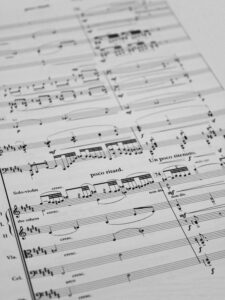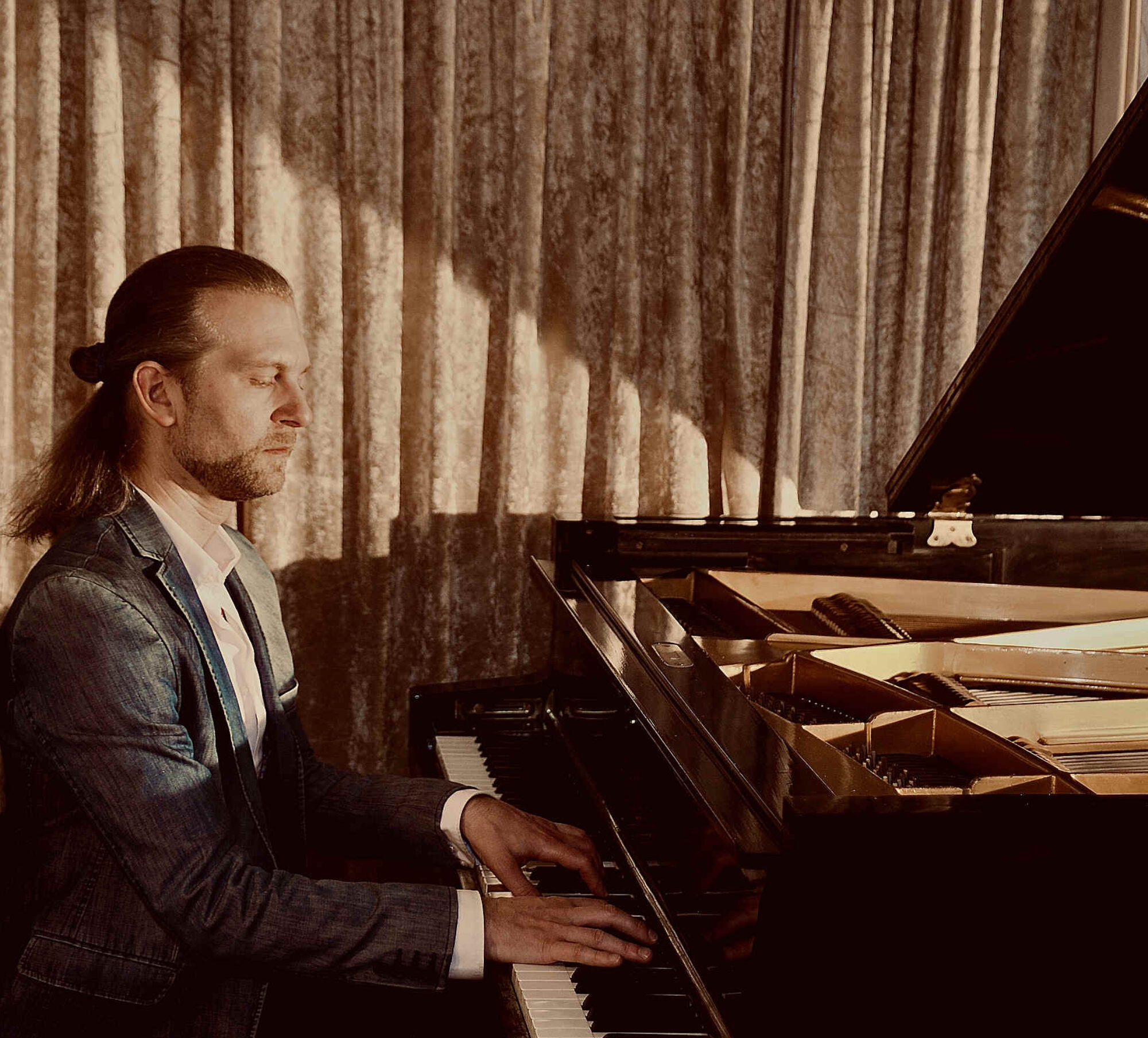2022
for piano and orchestra
dedicated to Wolfgang Rögner
- I. TRIBUTE TO RACHMANINOFF
- (Maestoso – Moderato)
- [15‘30]
- II. Intermezzo: MILONGA IN MACAU
- (Andante lento)
- [11‘]
- III. Finale: INVITATION TO DANCE
- (Vivace – Moto di Milonga)
- [9‘]
total duration: approx. 35–36 minutes
(Publisher: Ries & Erler, Berlin)


Composition commission by the Leipzig Symphony Orchestra in occasion of its 60th anniversary
Instrumentation:
- 2 Flutes (2nd doubling Piccolo)
- 2 Oboes
- 2 Clarinets in B b/in A
- 2 Bassoons
- 4 Horns in F
- 2 Trumpets in B b
- 3 Trombones
- Tuba
- Timpani
- Percussion I: Glockenspiel, Marimba, Vibraphone, Snare Drum, 3 Tom-Toms, Hi-Hat, Cymbal (pair), Suspended Cymbal, Tamtam, Cowbell, Headless Tambourine, Whip (Clapper), Ratchet, Claves
- Percussion II: Vibraphone, Bass Drum, Snare Drum, Triangle, Cymbal (pair), High Suspended Cymbal, Suspended Cymbal, Tambourine, 3 Temple-blocks, 3 Bongos, Castanets, Maracas, Woodblock, Gunshot (ad libitum)
- Strings
World Premiere: 15th September 2023, Kulturhaus Böhlen / Hannes Pohlit (piano), Angela Sallat & Andreas Küttner (dance), Leipzig Symphony Orchestra, Robbert van Steijn (conductor)
further performances: 27th August 2023 (Tagebau Profen/Elsteraue), 16th September 2023 (Lindensaal Markkleeberg), 17th September 2023 (Stadtkulturhaus Borna)
The live-recording of the World Premiere will be released in 2024 on CD (querstand records).
Preface
For the festival weeks celebrating the 60th anniversary of the Leipzig Symphony Orchestra, I was commissioned by director Wolfgang Rögner to write a piano-concerto with Tango-elements. After a preliminary concert – in the end of august, open air in the Profen open-cast mine (Elsteraue) – the premiere took place in September 2023 in the official anniversary-concert, accompanied by the performance of the Tango-dancers Angela Sallat and Andreas Küttner, who entered the stage at the beginning of the 2ndmovement, in a choreography they had created from the piece.
With my Paraphrases de Tango sur des mélodies de Carlos Gardel for solo piano (2012/2013) I have begun to revive the romantic Salon after the tradition of Franz Liszt, Sergei Rachmaninoff and Moritz Moszkowski in a Tango-inspired style: a process, which I called “classical crossover”, because I came to crossover as a classical composer. I combine this style – of course in a playful and entertaining way – with high standards of virtuosity on the piano as well as in the composition technique. As a pre-version of the concerto I created in December 2021 the Ballade de Salon (morceaux de concert), in which the themes and the form of the first movement are already indicated and which I premiered in my recital in Venice in January 2022. My piano concerto is both a homage to the Argentine tango of the “golden era” (with its most important protagonists Carlos Gardel, Francisco Canaro and Aníbal Troilo) and a tribute to the music of Sergei Rachmaninoff, in whose succession I would like to see it. As a composer who has so far published mainly “contemporary”, free-tonal music, I didn’t want to simply approach such a project naively. The first movement is also music “with Rachmaninoff”, because it is structured like the first movement of his first piano-concerto in F# minor. When composing this work, Rachmaninoff himself took Edvard Grieg’s A minor concerto as a model, just as Grieg was inspired by Robert Schumann’s piano-concerto; I wanted to place my concert in this tradition. Connoisseurs will find melodic allusions in the final bars of the main theme (by which the music means to say: “This is the starting point”) and in some accompanying figures. In the 2nd and 3rdmovements there are a few open, slightly modified quotations, which I understand as a dialogue with the composer of the past – similar to how Gustav Mahler evoked themes and motifs of Beethoven, Schumann, Liszt and Bruckner in his symphonies, perhaps similarly, as the novelist Umberto Eco subtly quoted from literature: a postmodernprocess. Just as books can talk about other books (or even with them, as Eco puts it in his novel The Name of the Rose), music can sometimes talk about other music.
What I love about Argentine tango is the emotionality and vitality, the rich chromatic harmony and theatricality, which feeds its sadness from a fundamentally nostalgic attitude to life that struggles with the present. Nostalgia is a strong feeling that can certainly have a unifying effect because many people experience and cultivate it at some point and it is the central theme in the lyrics of the famous tango cancions: “Tiempo viejo, ¿donde estas?” (“Old times, where Are you gone?”) asks the poet Alfredo Le Pera around 1930. While the first movement of my concert follows the classic form of the sonata movement with a solo cadenza before the coda, the second movement – in a loose sequence of double variations – tells of the mood on a milonga: of the subdued lighting and tense atmosphere, of the unification of the couple and their search for a common balance. In the variations of the middle section, the meter changes from 4/8 time (tango) to 3/8 time (tango vals) and back again. The third movement is characterized by the tripping momentum of the milonga, the fast, lively tango style and the rhythmic interaction developes to a confrontation between the solo instrument and the orchestra – with a happy ending. The Tango Concerto is warmly dedicated to the conductor and artistic director Wolfgang Rögner, who made this project possible with great commitment!
H. P.
Vorwort
Für die Festwochen zum 60jährigen Bestehens des Leipziger Symphonieorchesters erhielt ich von Intendant Wolfgang Rögner den Auftrag, ein Klavierkonzert mit Tango-Elementen zu schreiben. Nach einem Vorkonzert – Ende August open air im Tagebau Profen (Elsteraue) – fand die Uraufführung im September 2023 im offiziellen Festkonzert statt, begleitet von der Darbietung des Tango-Tanzpaares Angela Sallat/Andreas Küttner, die mit Beginn des zweiten Satzes die Bühne betraten, in einer von ihnen aus dem Stück entwickelten Choreographie.
Mit meinen Paraphrases de Tango sur des mélodies de Carlos Gardel für Klavier solo (2012/2013) habe ich begonnen, in einem Tango-inspirierten Stil den gehobenen romantischen Salon – in der Tradition Franz Liszts, Sergei Rachmaninoffs und Moritz Moszkowskis – wiederzubeleben: ein Verfahren, das ich „klassisches Crossover“ nannte, weil ich zum Crossover als klassischer (zeitgenössischer) Komponist gekommen bin. Diesen Stil verbinde ich – durchaus auf spielerische und unterhaltsame Weise – mit einem hohen Anspruch an die Virtuosität am Klavier wie auch an die Kompositionstechnik. Als Vorform des Tango-Concertos entstand im Dezember 2021 die Ballade de Salon für Klavier solo, in der Themen und Verlauf des ersten Satzes bereits angedeutet sind und die ich im Januar 2022 in meinem Recital in Venedig erstmals öffentlich spielte. Mein Klavierkonzert ist gleichermaßen eine Hommage an den argentinischen Tango der „goldenen Ära“ (mit seinen wichtigsten Protagonisten Carlos Gardel, Francisco Canaro und Aníbal Troilo) wie eine Liebeserklärung an die Musik Sergei Rachmaninoffs, in dessen Nachfolge ich es gerne sehen möchte. Als Komponist, der bisher weitgehend „zeitgenössische“, freitonale Musik veröffentlicht hat, wollte ich ein solches Projekt nicht einfach naiv angehen, sondern brauchte sozusagen einen „Vorwand“. Der erste Satz ist auch Musik „mit Rachmaninoff“, denn in der Form ist er aufgebaut wie der erste Satz seines 1. Klavierkonzerts Fis-moll. Rachmaninoff selbst hatte sich bei der Komposition dieses Werkes Edvard Griegs A-moll-Konzert zum Vorbild genommen, wie wiederum für Grieg das Klavierkonzert von Robert Schumann Pate stand; damit wollte ich mein Konzert auch in diese Traditionslinie stellen. Kenner werden melodische Anspielungen in den abschließenden Takten des Hauptthemas finden (womit die Musik sagen will: „Das ist der Ausgangspunkt“) und in manchen Begleitfiguren. Im zweiten und dritten Satz erscheinen ein paar wenige offene, leicht abgewandelte Zitate, die ich als Dialog mit dem Komponisten der Vergangenheit verstehe – ähnlich wie Gustav Mahler in seinen Symphonien Themen und Motive Beethovens, Schumanns, Liszts und Bruckners anklingen ließ, ähnlich vielleicht auch, wie der Romancier Umberto Eco aus der Literatur subtil zitierte: ein postmodernes Verfahren. Genauso wie Bücher über andere Bücher sprechen können (oder sogar mit ihnen, wie es in Ecos Roman Der Name der Rose heißt), kann Musik zuweilen von anderer Musik erzählen, ohne deshalb gleich „Musik über Musik“ zu sein.
Am argentinischen Tango liebe ich die Emotionalität und Vitalität, die reiche chromatische Harmonik und Theatralik, die ihre Traurigkeit aus einer grundsätzlich nostalgischen, mit der Gegenwart hadernden Lebenseinstellung speist. Nostalgie ist ein starkes Gefühl, das gewiss verbindend wirken kann, weil viele Menschen es irgendwann erfahren und kultivieren und in den Texten der berühmten Tango-Cancions ist sie das zentrale Thema: „Tiempo viejo, ¿donde estas?“ („Alte Zeit, wo bist du hin?“) fragt der Dichter Alfredo Le Pera um 1930.
Während der erste Satz meines Konzerts der klassischen Form des Sonatensatzes mit Solo-Kadenz vor der Coda folgt, erzählt der zweite Satz – in einer lockeren Folge von Doppel-Variationen – von Stimmungen auf einer Milonga: von der gedämpften Beleuchtung und gespannten Atmosphäre, der Vereinigung des Paares und seiner Suche nach einer gemeinsamen Balance. So wechselt in den Variationen des Mittelteils auch das Metrum von 4/8-Takt (Tango) zum 3/8-Takt (Tango-Vals) und wieder zurück Der dritte Satz ist geprägt vom trippelnden Schwung der Milonga, des schnellen, lebhaften Tango-Stils. Hier kommt nun besonders das rhythmische Element zum Zuge und das Zusammenspiel wird zu einer Konfrontation zwischen Soloinstrument und Orchester – mit Happy end. Das Tango-Concerto ist dem Dirigenten und Intendanten Wolfgang Rögner, der dieses Projekt mit großem Engagement ermöglicht hat, herzlich gewidmet!
H. P.
